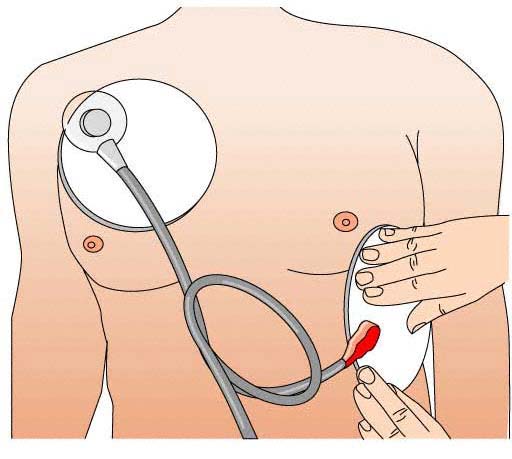Cardiopulmonary Resuscitation
Lesson 8: Administer CPR and Automated External Defibrillation (AED) on an
Unconscious Casualty with Suspected Cardiac Arrest.
8-2
8-2. PROCEDURES FOR INTEGRATING THE AUTOMATED EXTERNAL DEFIBRILLATOR AND CARDIOPULMONARY RESUSCITATION
It is important to know how to integrate the AED into the CPR sequence. If an AED is immediately available, it should be attached to the patient and treatment should be initiated. Delaying CPR at this point is justified because the defibrillation sequence will be started right away. If the AED is not immediately available or if CPR is already in progress, follow these steps.
a. Arrive on the scene and perform your initial assessment. Assess the patient for responsiveness. If the patient is responsive, do not apply the AED. A conscious patient may be in ventricular tachycardia, which is recognized as a shockable rhythm by the AED. It is not advised to shock a conscious patient with the AED.
b. Stop CPR.
c. Verify pulselessness and apnea. Check for “adequate” breathing and a pulse.
d. Resume CPR.
e. Prepare the AED.
f. Turn on the machine.
g. Remove the clothing from the patient's chest area and apply AED pads.
(1) Apply the two pads to the patients’ bare chest (figure 8-3). Apply one pad to the right of the sternum just below the clavicle. Apply the other pad to the left part of the chest with the top of the pad 2 to 3 inches below the armpit.

Figure 8-3. Proper placement of electrode pads.
(2) Ensure the pads are attached to the patient cables and that the cables are attached to the AED.
(3) Do not apply the AED pads over transdermal medication patches, implanted defibrillators, or pacemakers.
(4) For a patient with excessive chest hair, shave the areas under the pads before application.
h. Stop CPR.
NOTE: The AED will usually provide prompts for the proper sequence.
i. State aloud, “Clear the patient.”
(1) Once this is stated, look around the patient and make sure that no rescuer is still in contact with the patient.
(2) Look to ensure that the patient is not in contact with water or any other source of conduction that may cause you to be electrocuted by the defibrillator.
j. Push the analyze button.
NOTE: Do not touch or ventilate the patient during the analyze sequence.
k. If advised to do so, push the shock button.
NOTE: Before pushing the shock button, clear the patient again by verbalizing, “Clear
the patient,” and visually verify that all rescuers and equipment are away from
the patient.
l. After the shock is delivered, begin CPR.
(1) Begin chest compressions at a cycle of 30:2.
(2) Conduct 5 cycles of 30:2 (about 2 minutes of CPR) and then assess for adequate pulse.
(3) If an adequate pulse is detected, monitor the patient as described in paragraph 8-3. If an adequate pulse is not detected, repeat the defibrillation sequence.
m. Repeat the defibrillation sequence, if needed. Repeat the sequence of analyzing, shocking, and five cycles of CPR until on of the following occurs:
(1) Six shocks have been delivered.
(2) A “no shock advised” is issued by the AED
(3) The patient has a return of adequate spontaneous pulse.
n. Prepare the patient for immediate transport if.
(1) The patient has return of adequate pulse.
(2) Six sets of shocks have been delivered.
(3) The AED advises “no shock advised” and the patient is still pulseless.

